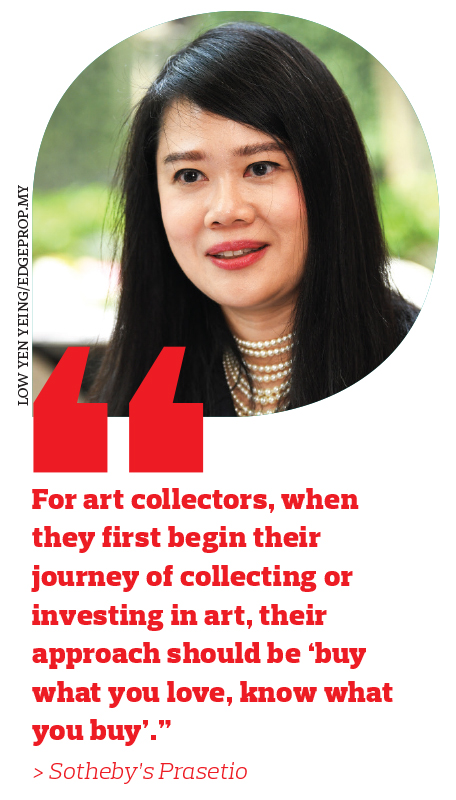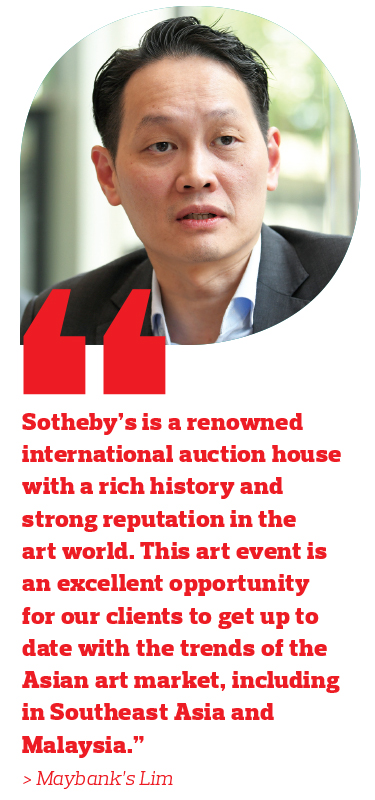This article first appeared in Wealth, The Edge Malaysia Weekly on July 22, 2024 – July 28, 2024
Maybank Private, the wealth management division of Maybank Group that serves high-net-worth and ultra-high-net-worth clients, has observed that there is a vibrant art scene in Southeast Asia. Younger faces are emerging, with some paying top dollar for art produced by globally and regionally renowned artists.
It is against such a backdrop that Maybank Private hosted an exclusive event in late June. Themed “Asian art market: In conversation with Sotheby’s”, the event featured expert discussions on the growing demand for art collecting in Asia. It also highlighted art collecting trends, valuations and opportunities in the Asian art market.
The event included a tour of the penthouse of The Residences at the St Regis, KL, for guests of Maybank Private to view famous artworks such as those by Andy Warhol, Roy Lichtenstein and Fernando Botero.
Sotheby’s, whose history dates back to 1744, is one of the world’s largest auction houses and brokers of art, collectibles, jewellery and real estate, among others.
During an interview with Wealth, Jasmine Prasetio, Sotheby’s managing director of Southeast Asia, says the vibrant art scene in the region is reflected in data gathered from the firm’s recent events.
Sotheby’s held its third auction in Singapore on June 9, which welcomed bidders from more than 20 countries. Over half of them were from Southeast Asia. New buyers accounted for 20% of the sales, with the majority of them below 40 years old.
Works sold at the event included those by Swiss artist Theo Meier, Indonesian abstract expressionist painter Ay Tjoe Christine, Vietnamese Asian modern and contemporary painter Tran Van Ha and Chinese painter Wu Guanzhong.
Meier’s and Ay Tjoe Christine’s works auctioned at the event quadrupled their estimated values. Tran’s art set a new record as its value rose six times against its estimated value, while Wu’s was sold at S$2.5 million (RM8.7 million), at 2½ times its estimated value.
“There is a growing number of collectors, especially among the next generation who are passionately engaged as patrons of the art [scene]. They often get involved in non-profit organisations and play an active role bridging institutions such as museums, with art produced by artists from the region,” she says.
Another trend that Prasetio has observed is that international contemporary art is on the rise and collectors are increasingly viewing it as an alternative asset class that complements their overall investment portfolios. “Patrons of art and other collectibles are definitely driven by passion [and not so much profit]. However, collectors today, when they buy art, are also thinking about asset allocation.”
According to Prasetio, other Southeast Asian artists who have done well include Singaporean painter Georgette Chan. As for Malaysian artists, Sotheby’s auctions the work of Chang Fee Ming, Yusof Ghani, Ibrahim Hussein and Latiff Mohidin, among others.
More art collectors see art as an investment
Lim Eng Peng, head of Maybank Private Malaysia, shares a personal experience of how art collections gained traction globally when he was the CEO of MIB Securities (Hong Kong) Ltd from 2017 to 2022. MIB Securities is Maybank’s securities and investment broker that serves clients globally.
It was in Hong Kong that Lim came across a documentary series about a village in Shenzhen that replicated the famous art pieces of Vincent van Gogh and sold them to European clients. He had an opportunity to visit the village later on and learnt about how art collection had been gaining traction globally.
Commenting on Maybank, Lim says the firm values innovation, creativity and enriching the community. It has always believed in the power of art to inspire and is committed to supporting various art activities.
“We have been supporting local artists, particularly through Maybank Foundation (a vehicle through which the Maybank Group carries out corporate responsibility initiatives). It is really a manifestation of our continuous commitment to the arts and culture,” he says.
Echoing Prasetio’s observation, Lim says more art collectors are viewing their art holdings as investments. This is despite their actions and decisions still largely being driven by their passion. This led Maybank Private to collaborate with Sotheby’s to provide their clients with more insights surrounding the art scene.
“Sotheby’s is a renowned international auction house with a rich history and strong reputation in the art world. This art event is an excellent opportunity for our clients to get up to date with the trends of the Asian art market, including in Southeast Asia and Malaysia.
“It is also a platform for our clients to engage with the team from Sotheby’s in a meaningful way, and to gain insights from industry experts. Through the panel discussion, our clients can enhance their understanding of art as an investment,” he says.
He adds that art is also a legacy asset where collectors can opt to pass on their collection to the next generation.
Asked about fund flows and returns, Prasetio and Lim point out that there isn’t much public data on the art market. Indices that accurately reflect the overall performance of the art market are also hard to come by.
How much an artwork is worth and valued is personal and subjective. But the general rule of supply and demand and market timing still apply to art investments. An investor should also know and understand the art and the artists well if they were to view it as an investment asset class.
“For art collectors, when they first begin their journey of collecting or investing in art, their approach should be ‘buy what you love, know what you buy’. It is like when you’re a stock investor; you want to buy companies that you like and know what companies you are buying into,” says Prasetio.
“The Wealth Report”, produced each year by the UK-based global real estate consultancy Knight Frank, could be a reference point to gauge the performance of alternative asset classes.
“The Wealth Report 2024” pointed out that art was the top performer last year among 10 alternative asset classes, which also included jewellery, watches, coins, coloured diamonds, wine, furniture, handbags, cars and rare whisky bottles.
As at the fourth quarter of 2023, art had generated 11% returns for investors in the past 12 months, followed by jewellery (8%) and watches (5%).
Over 10 years, art was ranked fourth in terms of return performance at 105% during the corresponding period. The top three were rare whisky bottles (280%), wine (146%) and watches (138%).
Save by subscribing to us for your print and/or digital copy.
P/S: The Edge is also available on Apple’s App Store and Android’s Google Play.



